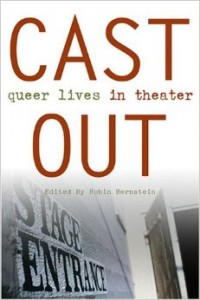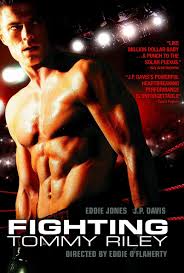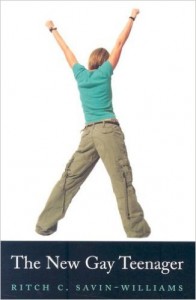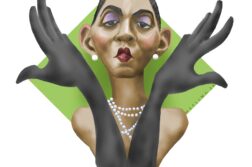 Cast Out: Queer Lives in Theater
Cast Out: Queer Lives in Theater
Edited by Robin Bernstein
Univ. of Michigan Press. 248 pages, 22.95
This collection of personal essays, interviews, and polemics, ably introduced and edited by Robin Bernstein, explores “queer theater history” from early inquiries into same-sex eroticism “on and off stage in ancient Greece and Rome” through scholarship that matches the texts and lives of Shakespeare and Christopher Marlowe. Starting in the 1920’s, anti-establishment theatre comprised of sexual bohemians (the Provincetown and Washington Square Players) laid some patchy same-sex groundwork, until we finally arrive on the threshold of a fully self-conscious gay manner, if not quite subject matter, in coded works by Tennessee Williams and Edward Albee, and in the musical scores of Stephen Sondheim. The Beats and hippie counterculture begot the underground theatre movement, especially the Caffe Cino in New York City, a breeding ground for gay plays by Lanford Wilson, William Hoffman, and Robert Patrick—and Charles Ludlam’s frankly camp Ridiculous Theater Company. These, in tandem with 1968’s seminal Boys in the Band, by Mart Crowley—and the masterful performance piece that was the Stonewall Riots—broke things wide open. Ellen Stewart’s La MaMa Experimental Theater Club hosted works by Maria Irene Fornes, transgendered Ethyl Eichelberger, and Jean-Claude van Italie. Lois Weaver and Peggy Shaw collaborated on WOW (Women’s One World), an international women’s theater festival, which mutated into the permanent theater space, the WOW Café, where Holly Hughes and Five Lesbian Brothers performed and from which the troupe Split Britches—“a sexy, campy centering of butch-femme identities and cultures”—emerged. Then, alas, came AIDS and its theatrical cri de coeur. Several personal memoirs stand out: Tim Miller offers an eyewitness view of the culture wars from the center of the tornado; Bree Coven maps her coming out in the theatre world with wry humor and some regret; Craig Lucas details the psychic pains of writing his dramatic truth amid the compromising blandishments of the marketplace, and the need to make common cause with others beyond the queer community. On balance, this is a sometimes maddening, often charming, occasionally slight series of essays and reminiscences.
Allen Ellenzweig
 Fighting Tommy Reilly
Fighting Tommy Reilly
Written by J. P. Davis
Directed by Eddie O’Flaherty
Featuring a compelling story and powerful performances by its co-stars, Fighting Tommy Reilly opened to critical acclaim in 2005. However, the film fell victim to an accident of timing: Fighting Tommy Reilly bears a superficial resemblance to Oscar winner Million Dollar Baby, released a year before. Because both movies center on a young boxer’s close relationship with a trainer, the low-budget, independent film was pigeonholed into a niche already filled by the Clint Eastwood blockbuster. Now featured on Logo TV, Fighting Tommy Reilly deserves to be considered on its own terms. In its sensitive portrayal of the complex relationship between a young athlete and the trainer who “discovers” him—an older gay man whose own budding boxing career had been cut short by homophobia—the film explores the explosive possibilities of male bonding between straight and gay sexualities. Written by the handsome young actor who plays Tommy Reilly, J. P. Davis, the film co-stars Eddie Jones as Marty Goldberg, a gay man nearing the end of life, who struggles with depression and regret over what might have been. Goldberg is a first-rate boxing coach and instantly recognizes Reilly’s undeveloped talent, which has been stunted by the disastrous tutelage of his first trainer, an abusive stepfather who crushed his will to compete. Under the gay man’s guidance, Reilly’s career flourishes; but Goldberg’s repressed sexual attraction to his protégé gives rise to tensions that leave both men reeling. The deep connection between Reilly and Goldberg is fraught with peril, particularly for the vulnerable older man. With insight and feeling, Fighting Tommy Reilly affirms human potential and attests to the heights of achievement that two people, each unappreciated and ineffective on his own, can attain when working together.
Don Gorton
 The New Gay Teenager
The New Gay Teenager
Ritch C. Savin-Williams
Harvard Univ. Press. 272 pages, 16.95 (paper)
Reports on the obstacles faced by non-heterosexual teenagers abound. Bullying, rampant drug abuse, depression, and even suicide top the list of problems. In The New Gay Teenager, Ritch Savin-Williams, a clinical psychologist and professor of human development at Cornell University, examines the extent to which a teenager’s mental health and sense of identity are actually connected to his/her sexual orientation. He argues quite forcefully that, despite these problems, many of today’s non-heterosexual youths are essentially coping quite well. They have developed a resilience that derives in part from the view that sexuality is only one component of a person’s identity, independent of one’s professional and academic goals, friendships, and political stands. In fact, many youths refuse to define their sexual identity based on their object of romantic or sexual attraction, as this is something that can change over time. Even teens who have sexual experiences only with same-sex partners may not identify as gay or lesbian. According to Savin-Williams, “the new gay teenager is in many respects the non-gay teenager,” rejecting the labels that categorize people according to their sexual orientation. Whether the reader agrees with Savin-Williams or not, this book makes a significant contribution to our understanding of non-heterosexual youths and is a must read for anyone who works with gay adolescents or conducts research on GLBT issues. The book will add to the author’s international reputation as an expert in the psychology and sociology of same-sex-oriented adolescents and young adults.
Trae Stewart






